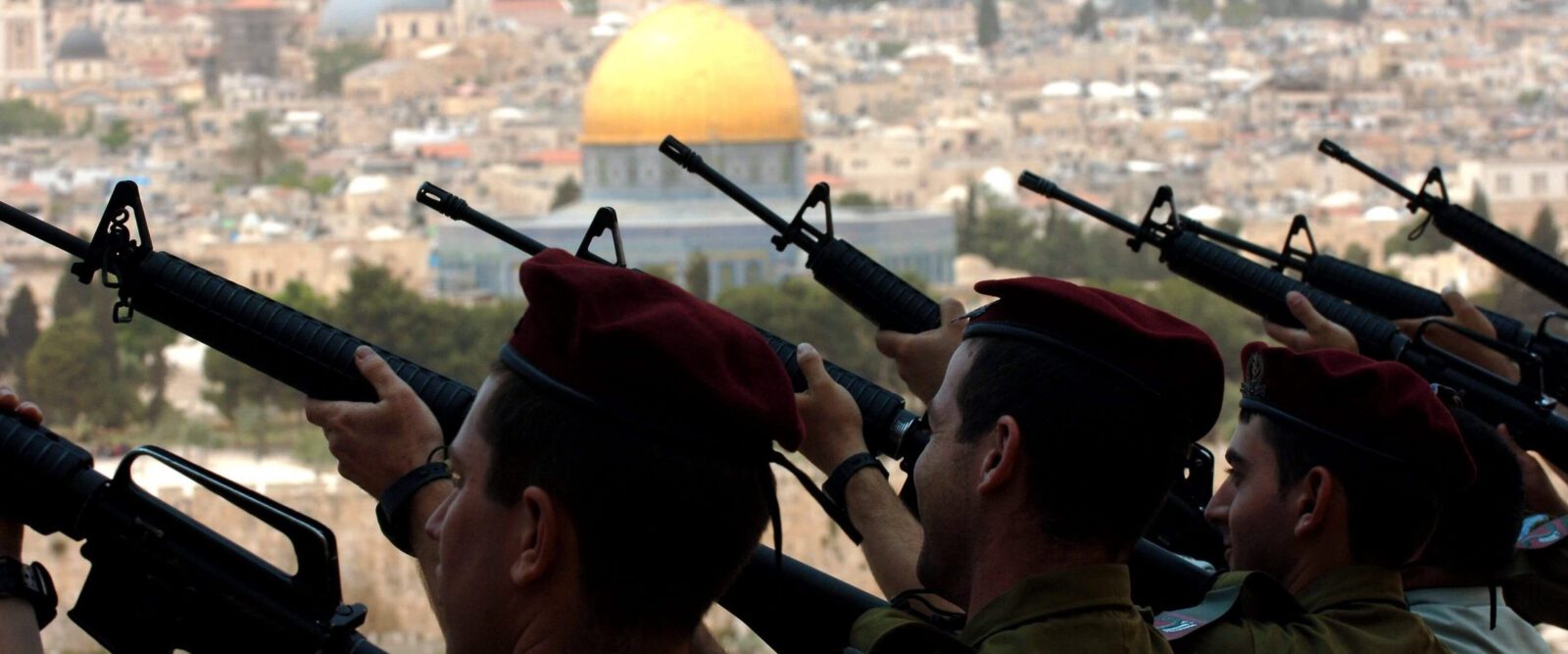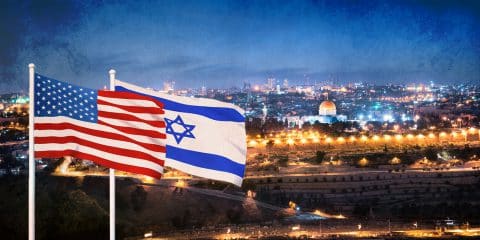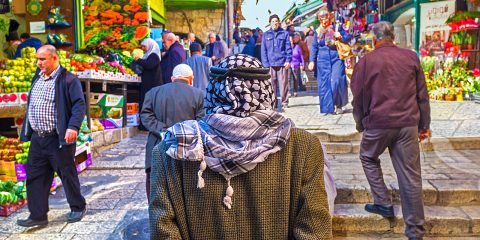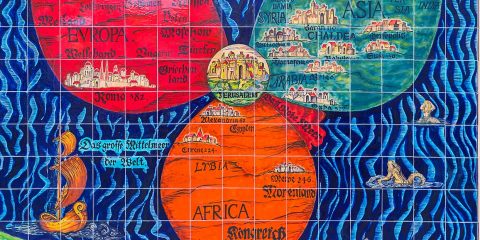Israel’s status in Jerusalem plays a role in the balance of power between rival camps in the regional arena. In fact, Israeli sovereignty in united Jerusalem serves as a vital anchor for the regional “Camp of Stability.” This explains Israel’s decision to take Jordanian and Palestinian interests into consideration when restoring the status quo ante following the July violence on the Temple Mount.
The dramatic conflict that erupted following the terrorist attack on the Temple Mount (July 14, 2017), and the clash that ensued regarding the placement of metal detectors at the entrance gates to the site, brought to light a variety of issues of far-reaching strategic and political significance.
Some had to do with regional dynamics, pertaining to Israel’s relations with her neighbors and with the Palestinian leadership. Others reflected political and ideological undercurrents among significant segments of the Arab population in Jerusalem and among Israeli Arabs. There were also internal Israeli tensions. This includes the significant controversy – that deteriorated to a vitriolic and undignified exchange – regarding the foundational positions underlying the intelligence assessments of the IDF and the General Security Service, and the way these assessments are perceived by parts of the political system.
A specific crisis broke out, concurrently, over the shooting incident in Amman, which heightened the dilemmas of the Jordanian government, on the one hand, and of the political system (and the public) in Israel, on the other hand. The deep-rooted hostility towards Israel in Jordanian society was a factor here.
Israel’s status in Jerusalem plays a role in the balance of power between rival camps in the regional arena.
This paper focuses upon one of these aspects: How Israel’s status in Jerusalem plays a role in the balance of power between rival camps in the regional arena. Indeed, this is the element that Israel’s leaders, specifically Prime Minister Netanyahu, ultimately came to see as the most significant aspect of the conflagration and its resolution.
The Questions Not Asked
Following the terrorist attack, and throughout the crisis, public and political discourse in Israel tended to focus primarily on the conflict with the Palestinians; on the (mutual) outburst of rage between Jordan and Israel; and mainly – on the true difficulty, in the eyes of many, to “swallow” decisions perceived as an affront to Israel’s national honor (and as a retreat on a legitimate security policy).
Amidst mutual accusations, not enough attention was paid to the significance of the events in the broader regional context. They need to be read, however, as related to the intensive struggle for the future of the Arab world, and to the current dynamics of a region torn between several distinct geo-political and ideological camps.
Thus, a retrospective examination of this aspect of the drama reveals surprising answers to several more fundamental questions that were neither posed nor answered with sufficient clarity: What led to the escalation of the crisis? What were the underlying factors that turned an essentially technical security procedure into a dramatic national and religious clash of wills? How did the “Arab world”– if this term still means anything – really react to the events, and to the fury and the rallying cries of “Takbir” (Allahu akbar) in Jerusalem?
What prompted decision makers in Israel to bring the crisis to its rapid end, making effective use of the situation created by the unexpected and unfortunate incident in Jordan? And why, despite the enthusiastic fervor and the sense of victory on the Palestinian side, did the incendiary incitement of the Palestinian Authority wane so abruptly, making way – at least for a while – to an atmosphere of “business as usual” (despite remaining rifts in security cooperation, and the later turn towards reconciliation with Hamas)?
The answer to these questions is found, to a large extent, in the linkage – or more precisely, in the systematic attempt to create a linkage – between the events in Jerusalem and the struggle currently brewing in the Arab world; an intensive and relentless struggle that pitches the “stability camp” headed by Egypt, Saudi Arabia and the United Arab Emirates, against the camp identified with the ideology of the Ikhwan (the Muslim Brotherhood).
The latter is currently centered in Qatar, backed by Turkey, and includes Hamas in Gaza (despite the latter’s attempt to obfuscate this in the Movement’s new policy paper), and in Israel through the Islamic Movement’s Northern Branch, under the vigorous and malicious leadership of Sheikh Raed Salah. The former came to be known as the “boycott states”, due to their recent actions against Qatar.
Given this linkage, a political and diplomatic reality has come into focus with great clarity. By virtue of her sovereignty in Jerusalem and her (complex) status in the holy places, Israel today holds one of the keys to regional stability.
By virtue of her sovereignty in Jerusalem, Israel today holds one of the keys to regional stability. Many key Arab actors actually prefer to preserve this situation.
Moreover, highly powerful entities in the Arab world actually prefer, and justifiably so, to preserve this state of affairs, using vague designations such as “the status quo” or the “historic rights to the Mount”.
Lip service is paid to Palestinian demands, but this preference is upheld in practice by the key players – if only to prevent this key asset from falling into the hands of their enemies and of the forces striving to undermine the existing political order. The status quo in Jerusalem also alleviates concern that one Arab entity within the stability camp will take control of the Temple Mount and increase its power at the expense of the others.
By virtue of her sovereignty in Jerusalem and her (complex) status in the holy places, Israel today holds one of the keys to regional stability.
The conflict this time is an internal Sunni one. The important and powerful camp of Iran and its allies, first and foremost the Hezbollah, did try to meddle in these recent events and to exacerbate the crisis. It applauded the popular rallying against Israel, but was nevertheless a secondary actor.
The main battle rages between Saudi Arabia and Qatar, and involves powerful economic interests (which is a godsend for conspiracy theory fans, particularly those of a Marxist hue), having to do with control of the world energy market and a great deal of money. It also reflects ancient local and tribal rivalries, unrestrained personal ambitions, and above all, a head-on clash between ideological outlooks.
This is a wide ranging historic conflict conducted on several fronts regarding the future of the Arab world and the nature of Islam. From the perspective of the Qatari-Turkish camp, it recently found itself facing serious adversity in this struggle, and hence its interest in diverting attention to Jerusalem.
This is a wide-ranging historic conflict conducted on several fronts regarding the future of the Arab world and the nature of Islam.
This struggle is being played out against the backdrop of profound changes taking place in the region since the beginning of the volatile regional events; what some hopeful people continue to call the “Arab Spring” despite the scope of the atrocities in Syria and in many other places. These traumatic events, in effect, brought about a new regional geo-political map. It was shaped not only by the balance of power and considerations of “raison d’état.” The new regional contours are strongly influenced by ideological and religious motives.
This is undoubtedly true even in countries which have held together – such as Turkey, whose leader is an Islamist and ideologically close to the Muslim Brotherhood. It also holds for Lebanon, which since the victory of the Hezbollah in the internal conflict in May 2008, is no longer a sovereign state in practice, and has become a sort of “empty shell” hijacked, by a terrorist organization that is an agent of Iran.
Other states have fallen apart too, among them Syria, Libya, Iraq, Yemen, and the Palestinian Authority – which is torn asunder. Thus, regional reality is realigning along ideational fault lines, intertwined with religious/ethnic and geo-political elements.
With several countries falling apart, four camps are in contention for regional hegemony.
Following the end of the cold war, the once-powerful nationalist-socialist camp in the Arab world (– in German, Nationalsozialismus sounds more explicit), went into sharp decline. The forces distinctly identified with the USSR – Nasserism, the Ba’ath, the “Rejectionist Front” – became increasingly irrelevant. At the other end of the spectrum, the tragic weakness of the liberal camp in the Arab world (they knew how to stir up a rebellion, but not how to hold on to power), has meant that only four effective camps are still in contention for regional hegemony.
The first camp is led by Iran, its offshoots and its allies, which we can term the radical Islamist camp. This has a prominent but not exclusively Shi’ite leaning, that currently controls four Arab capitals: Hezbollah as the hegemonic power in Beirut; Assad in Damascus, having survived owing to Iranian and Russian assistance; the “Popular Mobilization” militias (al-Hashad al-Shabi) in Iraq that played a key role in the liberation of Mosul and are controlled by the “al-Quds Force” of the Iranian Revolutionary Guard Corps; and the Houthi rebels in Yemen that control the capital Sanaa and are also identified with Iran.
This camp, of course, opposes the status quo in Jerusalem, yet its influence during the latest crisis was relatively limited.
The second camp is the Salafi-Jihadi camp, and since 2014 at its core is the “Islamic State” with its pretensions to renew the Caliphate. This is an extreme ideological camp that at its peak controlled large parts of Iraq and “Sham” (the historical term that encompasses Syria, Lebanon, Jordan and the Land of Israel), and also expanded to what it saw as the Muhafazat (districts) of the “State” in Libya, Sinai and even western Africa.
This camp, too, obviously opposes the status quo in Jerusalem. But given its fight to survive in Iraq and Syria, it played only a marginal role in the Temple Mount events, although its messages helped radicalize elements among Jordanians, Palestinians and Israeli Arabs.
The third camp is the one identified with the world view of the Muslim Brotherhood (MB), and is at the center of the political drama of summer 2017.
This camp was significantly strengthened after the presidential elections in Egypt in May 2012 that brought the Muslim Brotherhood’s candidate, Muhammad Morsi, to power. Nonetheless, after he was removed by the military in July 2013, and the Brotherhood retreated in Tunisia as well, the only remaining centers of Muslim Brotherhood power are the Hamas regime in Gaza, and in part the government in western Libya.
However, in many countries the MB has a robust organizational and social infrastructure, overt or covert, including the northern branch of the Islamic Movement in Israel. Moreover, these elements and movements enjoy the manifest, active and extensive support of two key countries – Turkey under the leadership of Erdoğan, and the Emirate of Qatar – which have places their resources and influence at the disposal of this camp. In this case, both offered support for the effort to overthrow the status quo in Jerusalem.
Facing these three camps stands what can be called the “camp of stability” – diverse forces acting to prevent destabilization of the existing order and to forestall increased Islamist power.
This camp is not fully coordinated, and its elements do not always share the same priorities. For Saudi Arabia, the United Arab Emirates and Israel, Iran is the primary enemy; whereas for Egypt as well as for the Palestinian leadership in Ramallah it is the Muslim Brotherhood and its offshoots (including Hamas) which poses the distinct existential danger, while Iran is the threat over the horizon.
In the face of the Turkish challenge this strategic camp also has room for Cyprus, Greece and like-minded countries in the eastern basin of the Mediterranean. Members of this camp are by definition in favor of the status quo in Jerusalem, mainly in order to prevent any competing entity – outside and even within the camp – to gain and consolidate its status in Jerusalem and on the Temple Mount.
The “game of camps” is played out throughout the region, and often creates unexpected and even problematic combinations of forces.
The “game of camps” – the struggle between all four for regional hegemony, and even for sheer survival – is played out in different contexts throughout the region, and often creates unexpected and even problematic combinations of forces. There has been a degree of cooperation between the US, the Kurds and the Iranian-supported militias as part of the battle in Mosul. Elements tied to the Muslim Brotherhood worked with European powers in the battle to eradicate ISIS in central Libya. The struggle is often brutal, as Syria and Yemen attest.
An analysis of the characteristics of the conflict between Saudi Arabia and its partners, on one hand, and Iran and its satellites on the other, is outside the scope of this paper.
Still, it is important to emphasize that President Trump’s visit to Saudi Arabia increased the confidence of the current Saudi leadership. It was followed by the internal upheaval in the royal family that resulted in the ousting of Mohammed bin Nayef as heir to the throne in favor of Mohammed bin Salman, the King’s son and the Minister of Defense. This further increased Saudi willingness to take belligerent and aggressive measures to reinforce their status – and to strengthen the “stability camp” in the regional power struggle.
Thus, against the backdrop of growing indications of the imminent collapse of the “Islamic State”, the Saudis – along with the Egyptians, Bahrain and the Emirates, and with some qualified support from other elements in the Arab world – have turned to deal head-on with the Muslim Brotherhood camp, focusing on Qatar and its role (and indirectly also on Turkey).
This specific conflict is not new. Turkey and Qatar encountered Egyptian (and Israeli) opposition whenever they attempted to intervene in Gaza during Operation Cast Iron (December 2008- January 2009), Operation Pillar of Defense (November 2012) and Operation Protective Edge (summer 2014). Again and again, the diplomatic mediation efforts of the Turkish and Qatari foreign ministers, backed to some extent by the Obama administration, were rebuffed, less and less politely.
Had Israel agreed to have Turkey and Qatar lead the negotiations to end Operation Protective Edge, it is reasonable to assume that cessation of fighting could have been reached much sooner – but at the price of profound damage to the status of Egypt and to the power and influence of the “stability camp” at large. Then, as during the current crisis, Israel acted as an organic part of the stability camp, and was willing to endure prolonged fighting to ensure Egyptian control of the Gaza endgame.
Elsewhere, over the past two years, the second round of the civil war in Libya – between the government in Tripoli, that relies on the Misrata militia and the political power of the Muslim Brotherhood, on one side, and the regime of General Khalifa Haftar, who is backed by Egypt on the other side – has also become a proxy war of sorts between Turkey (supported by Qatar) and Egypt (supported by the Emirates), respectively.
At the level of information warfare, a bitter propaganda battle has been raging for years between the Qatari-owned Al Jazeera – whose influence is so extensive that there are those who have called Qatar “the oil well with the television station” – and the pro-Saudi Al Arabiya. Following Operation Protective Edge Qatar was under strong pressure to restrain the blatant incitement against President al-Sisi and the Egyptian government, but the results were limited and temporary.
Against this backdrop, the decision of Saudi Arabia, the Emirates, Egypt and their partners to sever ties with Qatar, to impose sanctions and to condemn it before the court of Arab and world opinion, did not come as a surprise. There was a change in style (more aggressive and scathing than in the past) and in the intensity of the conflict, which quickly deteriorated to high tones and unprecedented accusations. This included demands to close Al Jazeera and to remove the Turkish military base from Qatar, and on the other side the Qatari call to expropriate control over the holy sites of Islam from the House of Saud.
Mediation efforts by Kuwait and others, backed by US Secretary of State Tillerson, have so far been unsuccessful.
The decision of Saudi Arabia, the Emirates, Egypt and their partners to sever ties with Qatar and impose sanctions did not come as a surprise.
Thus, the Muslim Brotherhood camp faced the urgent need to divert attention from the Qatari crisis and to question the legitimacy of the regimes that cooperate with Israel. Even if there is no direct evidence that the terrorist attack on the Temple Mount on July 14, 2017 was planned for this purpose, it was undoubtedly the product of continuing incitement – “al-Aqsa fi khatar” (Al-Aqsa is in danger).
This has been led by an element from among Israeli Arabs distinctly identified with this camp, namely, the Northern Branch of the Islamic Movement, which took action to support the Brotherhood’s cause. There is also a basis to assume that the Turkish leadership used the range of operational levers (social activities, educational institutions, funds) it had developed in recent years in the Arab neighborhoods in Jerusalem, in order to expand and deepen unrest, to heighten the influence of Islamist ideologies, and to undermine Jordanian and Israeli control on the Temple Mount.
The Answers from a Regional Perspective
Thus, certain answers can be offered to the questions posed at the beginning of this paper.
Why did the crisis escalate?
Beyond the terrorist attack itself, with its specific background still under investigation, it can be said with certainty that highly influential (and affluent) elements were very interested in thwarting Israel’s calming efforts, efforts which were initially joined by Jordan – and even the Palestinian leadership in Ramallah – at the stage immediately after the attack.
With the help of the incitement mechanisms at their disposal, in the media, online and in the field, they were able to turn the question of Israel’s practical security measures (on which it appears that it could have been possible to reach agreements with the PA and Jordan, before the incitement intensified) into a principle bone of contention aimed at inciting the Arab world.
The Northern Branch of the Islamic Movement, that was outlawed in Israel but whose leaders continued at the time to act without any restraint, also played an important role in instigating these actions. It did not hide its affinity for the Qatari position in the Saudi crisis, and acted with a clear intent to change the focus of the debate in the Arab world.
The crisis escalated because influential regional players had an interest in foiling Israel’s efforts to restore calm.
How did the “Arab world” react to the events in Jerusalem?
In this respect the inciters were very successful in their mission among the population in the areas under Palestinian Authority control, as well as in Jordan – two focal points that can be viewed as the Achilles heel of the stability camp. In both, the political leadership may have been interested in calming the situation, but had difficulty withstanding pressure from the “street.”
For Mahmoud Abbas, operating from a distinctly weak position, the Temple Mount events also posed a temptation to take advantage of the escalation to oust Jordan from Jerusalem, to improve his own political situation, and to strengthen his bargaining position vis a vis the US negotiating team headed by Jared Kushner (whom the Palestinians perceive as unsympathetic to their demands regarding the final status agreement).
Conversely, the remaining Arab world, with an emphasis on the key countries of the stability camp, “shrugged their shoulders” and chose to ignore the drama on the Temple Mount. Social media networks in Arabic even spread a supposed quote by the Imam of the holy sites in Mecca that this is “an internal Israeli problem”!
Herein lays one of the important and significant lessons from the crisis; an understanding that grows clearer after the propaganda dust settles and the reality of the situation reveals itself. To the chagrin of the Palestinians, their calls to magnify the crisis, and their attempts to exploit the events in order to make additional political demands – did not find a sympathetic ear in Cairo or in Riyadh.
In contrast with the tendentious portrayal to the Israeli public, there was no threat that Israel’s relations with the stability camp. As a matter of fact, the stability camp does not actively support the Palestinians, aside from the expression of empty slogans for the transfer of Israeli sovereignty (and control) on the Temple Mount to the Palestinians as demanded by the Palestinian National Movement.
Moreover, the overall impression is that this is how most non-Arab Moslem countries reacted – which the obvious exceptions of Turkey and Iran which tried but failed in influencing the trajectory of the crisis.
The inciters made gains among Palestinians and Jordanians, but the rest of the Arab World shrugged its shoulders.
Why did the government of Israel choose, at the critical stage, to “bite the bullet” and remove the new security devices?
The answer to this question is that it was critical – as soon as the effectiveness of the incitement in the internal circle in Jerusalem, in the Palestinian street and in Jordan became apparent– to do “damage control.” It was important to act quickly to calm the situation, alleviate the tension and take the issue off the table.
This was the case, not because of the threat of violence against Israel and its citizens (to which there are many ways to respond), but due to the tangible threat that began to emerge to the status of King Abdullah and of Mahmoud Abbas.
Inflammatory voices in Israel were ready to take strong action against both of them. However, the overall interest of the stability camp required a cautious policy that would not give Erdoğan and the Muslim Brotherhood additional opportunities and reasons to meddle in muddy waters. (This is exactly what Erdoğan tried to do in the discussions of the Organization of Islamic Cooperation, the OIC, about one week afterwards).
An overall regional strategic perspective – not a caving-in to the pressure of the street – played a major role in Israel’s decision to return to the previous status quo. This was mainly a gesture to Jordan (with which Netanyahu had to deal anyway because of the security guard incident); so that other and more problematic elements in the region would not be able to claim that “victory” was achieved due to their intervention.
Israel chose to act swiftly to restore stability not because of the threat of violence but out of concern for the position of King Abdallah and of Abbas.
Why did calm prevail?
The moment all new security devices placed by Israel were removed, a pressing need arose among the stability camp to reduce the tension – since, as noted, a dangerous drift in the direction of “popular action” in order to achieve strategic leverage was discernable among the Palestinian leadership.
It appears that Abbas received a “cold shower” prior to the Friday prayers on July 28th, which indeed proceeded peacefully, from both the US and the Saudis. They apparently told Abbas that he must restrain himself and his people before they lose their political status (especially when many in Washington are already calling to halt the assistance to the Palestinian Authority). The combination of calming messages from the Palestinian side, measures taken by Jordan in the field (despite the tension regarding the security guard), and the popular desire to “declare victory and go home,” contributed to the rapidly reduced level of friction.
Abbas’ weaknesses, and the sensitivities of the Jordanians, are therefore the fundamental reasons underlying Israel’s management of the crisis (and the question of the Temple Mount in general). In a world where there is no political meaning to the saying “a nation unto itself,” Israel acted to serve the broadest interest of the camp, which is also in her own strategic interest. At the same time, this pragmatic stance was obscured due to the need to placate internal vocal Israeli political elements.
The other side of the same coin is that the stability camp in general, and Jordan specifically, has a clear interest to preserve the “historical rights” and the status quo on the Mount; which in reality means that Israel remains the sovereign power.
Relinquishing Israel’s sovereignty over the Holy Basin and the Temple Mount would result in Palestinian takeover of all the holy sites. Arafat, after all, liked to compare himself to the Caliph Omar [the Muslim conqueror of Jerusalem], who signed a treaty – Al ‘Uhdah Al- Omaria – with the Christians in the city (without addressing any Jewish rights). Other Arab elements as well, even those within the camp – from Saudi Arabia itself through Morocco – covet control over “Ulat al-Qiblatayn” (the first direction of the prayer, one of the names of Jerusalem in Islam).
The Camp of Stability has an interest in preserving the “Historic Rights” and the Status Quo on the Mount, with Israel as the actual sovereign.
Under these circumstances, if Israel ever relinquished control, Jordan would lose its status and legitimacy. Under pressure from the Muslim Brotherhood camp (that without the help of Israel, the Palestinian Authority would not be able to withstand) the Temple Mount would become a pivotal historic symbol of the victory of radical Islam.
This is a result that most of the Arab world today would view as disastrous. Israel’s sovereignty over a unified Jerusalem, especially in the Holy Basin, is therefore the vital cornerstone for continued viability of the stability camp and for the prospect of regional stability.
This will remain true as along as Israel’s leadership continues to act cautiously, judiciously, and with an informed assessment of internal Arab dynamics.
Key players in the regional arena are not eager to commit to conflict resolution, but have a vested interest in prudent conflict management.
The events also provide lessons regarding the centrality and degree of importance of the Palestinian question in the eyes of the Arab world.
It serves to indicate that the key elements in the regional political arena are not enthusiastic about investing extraordinary efforts in order to achieve a permanent final status agreement that would lead to a solution to the problem, i.e. what is known as conflict resolution. But they do have a clear interest in conflict management. In other words, they have an interest in sagacious management by Israel of the situation in the territories and in Jerusalem, without letting intermittent skirmishes deteriorate into high visibility conflict (– what is referred to as “television screens dripping blood”). This would only play into the hands of hostile elements from the radical camps.
Policy Recommendations
Now that things have calmed down, the government of Israel would do well to act on several channels simultaneously. Israel should:
Maintain restraint, at least in the interim period, in all matters relating to visits of Jews to the Mount, so as not to play into the hands of the Muslim Brotherhood or help them deepen the rift with Jordan.
Simultaneously, stiffen the message that Israel does not plan to relinquish its sovereignty in Jerusalem and transfer it to any Arab element. (The currently-proposed “Jerusalem Law” would contribute to clarifying the situation).
Institute more effective barriers to impede the activities of the Northern Branch of the Islamic Movement, especially in Jerusalem.
Tighten surveillance of Turkey’s subversive activities in Jerusalem and formulate response modes. Perhaps there is room for a more aggressive approach towards Turkey.
Help the Jerusalem municipality deepen its direct influence among the Arab residents, employing a range of measures and tools (including significant and focused investment in improving infrastructures and building education institutions).
Restore relations with Jordan, including a formal solution to the security guard incident, and increase coordination with the Jordanian Waqf. At the same time, Israel should be sending an indirect warning message to the King regarding the intensity of hostility toward Jordan that was revealed among parts of the Israeli public during the crisis. This requires very cautious behavior on both sides of the river, also in all matters relating to hostile Jordanian activities in international institutions.
Perhaps conduct a “case debriefing” with the appropriate entities in Egypt (and Saudi Arabia?) without granting them any status in Jerusalem, in order to learn the lessons and deepen coordination opposite Qatar and Turkey.
Identify influence levers over the internal (stormy) discourse in the US administration regarding the overall regional situation, and encourage those that advocate a tough but sober stance against both Iran and the Muslim Brotherhood.
In summary, the credit Israel gained in regional context due to the cautious way it conducted itself during this crisis must be exploited in order to coordinate positions and strengthen the stabilizing forces in the region. The US should be encouraged to help ease the tension with Jordan, as well as to reduce the inflated level of expectation on the Palestinian side about possible “solutions” in Jerusalem.
Photo credit: Avi Ohayon, GPO.









 - בניית אתרים
- בניית אתרים